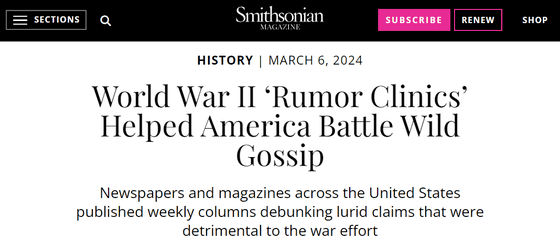During World War II, newspapers and magazines across the U.S. conducted 'disinformation clinics' to check for misinformation and fight ridiculous rumors.

In today's world where SNS has become widespread, once fake news and misinformation are published, they spread instantly, and it is common for a certain number of people to be fooled by such false information. Smithsonian Magazine, a science and history blog, explains that in the United States during World War II, there were many rumors circulating, so there was an initiative called ` `rumor clinics' ' to crack down on them. .
World War II 'Rumor Clinics' Helped America Battle Wild Gossip | History | Smithsonian Magazine

During World War II, disinformation spread not only by agents of enemy nations such as Germany, Italy, and Japan, but also by American citizens themselves, became a major problem in the United States. These rumors undermined support for the war and incited racial and religious tensions. At the time, there was no internet or social media, but rumors spread by word of mouth.
For example, false rumors such as ``Black soldiers aboard the Queen Mary are being sent on suicide missions'' and ``Jewish soldiers are exempt from being sent overseas'' were spread. Also, ``We have been instructed to destroy surplus vegetables from wartime gardens,'' ``War bonds will not be redeemed,'' ``Blood donation is unsanitary and a waste of blood,'' and ``Soldiers returning from Alaska have brain freeze.'' There were also many false rumors such as ``The presidential election was canceled.''

Additionally, false rumors about First Lady Eleanor Roosevelt are being spread. The hoax, known as the 'Eleanor Club,' claimed that Mrs. Eleanor was calling for black domestic workers to go on strike and force their white employers to do their housework. The 'Eleanor Club' is said to have become so widespread that the FBI investigated it and the attorney general publicly denied it.
In February 1942, activist Francis Sweeney consulted with the Boston Herald to counter the spread of these false rumors. At the suggestion of Gordon Allport, a psychologist at Harvard University, ``rumor clinics'' were established, and a movement to investigate and report on the truth or falsity of false rumors began. This spread across the United States, with more than 40 newspapers and magazines doing the same.
Frances Sweeney and fellow reporter William Harrison featured in Life magazine, Oct 1942.
pic.twitter.com/TtMvI32Kkr — Maurice J Casey (@MauriceJCasey) January 26, 2021
Sweeney was an Irish American reporter whose journalism exposed far-right organizing and antisemitism (particularly among Irish Catholics). She died in 1944, aged 36.
At the Misinformation Clinic, 'misinformation monitors' made up of reporters and local volunteers collect rumors submitted by readers and verify the facts. The results of the survey were published on the front page of the paper.

Allport et al. analyzed 1,000 false rumors collected in the summer of 1942, and found that 65.9% were 'divisive' rumors that aimed at division by inciting racial and political conflicts, and 25.4% were 'fearful' rumors that aimed to incite anxiety. ”, showed that 2% were classified as “aspirational”, which reflects aspirations. Another theory has been proposed that the spread of false rumors is related to the combination of the importance and ambiguity of the topic.
After World War II ended, similar efforts were carried out across the United States, such as misinformation clinic lectures and the establishment of anti-disinformation hotlines during the racial tensions of the late 1960s.
Smithsonian Magazine says, ``Today, the flow of information and political culture have changed so much that the same methods that were used back then no longer work.However, human nature remains the same, and there will always be people who believe in unfounded information.'' ``Not only the media, but society as a whole needs to think about how to deal with false rumors.''
Related Posts:
in Note, Posted by log1i_yk







